“They were in a photograph taken in 1921 which we found in a picture library…. I very carefully photographed Jack, matching the angle and the lighting of the 1921 photograph, and shooting him from different distances too, so that his face would be larger and smaller on the negative. This allowed the choice of an image size which when enlarged would match the grain structure in the original photograph. The photograph of [Jack's face] was then airbrushed in to the main photograph, and I think the result looked perfect…."
The photo of Jack is not real. His face was airbrushed onto someone else's body.
.
Sunday, December 13, 2009
The Black Frames.
Most of the hints that Stanley Kubrick gives us as to an exact date when the action in "The Shining" takes place are shown to us on the 12 black frames of the movie. We know that the Torrance’s first full day alone in The Overlook is Halloween as Mr. Ullman tells Jack the hotel closes on 10/30, and they arrive on closing day. The 4th black frame says, "One Month Later" and this is November 30, the 11th month. No year is given in the film or in the novel but it was published in 1977 and the film was released in 1980. If we literally go by the black frames the date of Wendy and Jack"s fight in 1980 would be 12/11. In Stephen King's novel we're told it's December 2 (page 209 chapter 37 "The Ballroom" and page 251 chapter 46 "Wendy"). "Suddenly a huge clock in a glass bowl materialized in front of it. There were no hands or numbers on the clock face, only a date written in red: DECEMBER 2. And then, eyes widening in horror, he saw the word REDRUM reflecting dimly from the glass dome, now reflected twice. And he saw that it spelled MURDER." Remember also that there are 12 black frames as the movie starts and ends on black frames that contain no writing.
The beginning (0:00).
The interview (0:03).
Closing day (the day before Halloween - the 30th of October) (0:17).
A month later (the 30th of November) (0:34).
Tuesday (December 2) (0:40).
Thursday (December 4) (0:45).
Saturday (December 6) (0:46).
Monday (December 8) (0:51).
Wednesday (December 10) (0:56).
8 AM (December 11) (1:35).
4 PM (December 11) (1:54).
The End (2:23).
Using a 1980 calender the fight and the last night they spend together inside The Overlook is Thursday night December 11.
.
The beginning (0:00).
The interview (0:03).
Closing day (the day before Halloween - the 30th of October) (0:17).
A month later (the 30th of November) (0:34).
Tuesday (December 2) (0:40).
Thursday (December 4) (0:45).
Saturday (December 6) (0:46).
Monday (December 8) (0:51).
Wednesday (December 10) (0:56).
8 AM (December 11) (1:35).
4 PM (December 11) (1:54).
The End (2:23).
Using a 1980 calender the fight and the last night they spend together inside The Overlook is Thursday night December 11.
.
Thursday, November 26, 2009
F5
Delbert Grady has to be in the final photo. This is totally overlooked by many but so important; if Grady is a real spirit haunting The Overlook he would be in the final photo as he's the highest ranking "ghost" and actually succeeded in killing his family. He even says, “I'm sorry to differ with you, sir, but you are the caretaker. You have always been the caretaker, I should know, sir. I've always been here.” If he has in fact “always been” in The Overlook than he must also be in the final photo and he, like when we see Jack, must look exactly the same. He obviously isn’t in the final photo and this has only one explanation; he hasn't "always been" there as he's a product of Jack’s imagination. A person suffering from cabin fever. Just a sick man's vision and not a real board certified, "ghost".
.
.
F4
You can not be the reincarnation of someone who is alive at the same time you are. Stanley Kubrick puts a clue in the dialogue that proves Jack in the present day Overlook could not in any way be a reincarnation of Charles Grady (who killed his family and himself) or Delbert Grady (the putative “ghost”).
Listen to the bathroom conversation between the two, Charles Grady and Delbert Grady appear on the surface to be the exact same person, but they aren’t. Delbert Grady is lying to Jack when he tells him his name as we know from the interview his real name is Charles Grady. Delbert and Charles are two different entities. One is a real person and the other isn’t. "Remember what Mr. Hallorann said. It's just like pictures in a book, Danny. It isn't real.” Delbert Grady is a vision that looks exactly like the real Overlook caretaker Charles Grady, but they are not the same person. We know this positively from the dialogue Stanley Kubrick put in the movie. Jack says this as he talks to himself in the bathroom, “Mr. Grady. You were the caretaker here. I recognize ya. I saw your picture in the newspapers.” There’s something here that movie viewers who have never read the novel are not aware of. When Jack says, “I saw your picture in the newspapers” he's referring to the very important unexplained scrapbook that we see open on his desk throughout the movie (The scrapbook plays a big part in the novel as it’s in the basement and used by “the manager” to lure Jack. It contains articles about the hotel's less savory guests and Jack eventually decides to use it to work on a different project apart from the play he was working on, about The Overlook’s past). In the movie Jack knows exactly what all of the previous hotel guests, who aren't "all the best people", look like after he opens up the scrapbook. The book is just as important in the film but we don't realize it at first.
When he says, “I saw your picture in the newspapers” he already knows what Charles Grady looks like. You don’t know what Grady really looks like, but Jack does. Delbert Grady, “the ghostly vision”, and Charles Grady, “the caretaker”, look exactly the same and Jack is the only one who knows this for sure. He’s imagining talking to the person he idolizes, the same Charles Grady that he’s seen in the newspaper clippings who killed his family and himself in 1970. The major problem is this; there can’t be any reincarnation of these two people (“You have always been the caretaker”) because of what we're told in the interview by Mr. Ullman. The two little girls were killed in 1970. Jack and Charles Grady, when he worked at the hotel, were both alive at the same time. Grady’s lying when he says this line to Jack in the bathroom conversation “You are the caretaker, you have always been the caretaker” as they were obviously both alive at the same time in 1970, and are two entirely different people. This can’t be debated or changed no matter what your opinion is. Again, you can’t be the reincarnation of someone who is alive at the same time you are.
Stanley Kubrick even tells us in the dialogue that Delbert Grady "isn't real", and this should be no shock as he along with the rest of the party goers are all a vision we’re seeing from inside Jack’s imagination. It's all because he’s looked at their pictures in the scrapbook. Again Stanley Kubrick points us to this in the dialogue, “Remember what Mr. Hallorann said. It's just like pictures in a book, Danny. It isn't real.”
.
Listen to the bathroom conversation between the two, Charles Grady and Delbert Grady appear on the surface to be the exact same person, but they aren’t. Delbert Grady is lying to Jack when he tells him his name as we know from the interview his real name is Charles Grady. Delbert and Charles are two different entities. One is a real person and the other isn’t. "Remember what Mr. Hallorann said. It's just like pictures in a book, Danny. It isn't real.” Delbert Grady is a vision that looks exactly like the real Overlook caretaker Charles Grady, but they are not the same person. We know this positively from the dialogue Stanley Kubrick put in the movie. Jack says this as he talks to himself in the bathroom, “Mr. Grady. You were the caretaker here. I recognize ya. I saw your picture in the newspapers.” There’s something here that movie viewers who have never read the novel are not aware of. When Jack says, “I saw your picture in the newspapers” he's referring to the very important unexplained scrapbook that we see open on his desk throughout the movie (The scrapbook plays a big part in the novel as it’s in the basement and used by “the manager” to lure Jack. It contains articles about the hotel's less savory guests and Jack eventually decides to use it to work on a different project apart from the play he was working on, about The Overlook’s past). In the movie Jack knows exactly what all of the previous hotel guests, who aren't "all the best people", look like after he opens up the scrapbook. The book is just as important in the film but we don't realize it at first.
When he says, “I saw your picture in the newspapers” he already knows what Charles Grady looks like. You don’t know what Grady really looks like, but Jack does. Delbert Grady, “the ghostly vision”, and Charles Grady, “the caretaker”, look exactly the same and Jack is the only one who knows this for sure. He’s imagining talking to the person he idolizes, the same Charles Grady that he’s seen in the newspaper clippings who killed his family and himself in 1970. The major problem is this; there can’t be any reincarnation of these two people (“You have always been the caretaker”) because of what we're told in the interview by Mr. Ullman. The two little girls were killed in 1970. Jack and Charles Grady, when he worked at the hotel, were both alive at the same time. Grady’s lying when he says this line to Jack in the bathroom conversation “You are the caretaker, you have always been the caretaker” as they were obviously both alive at the same time in 1970, and are two entirely different people. This can’t be debated or changed no matter what your opinion is. Again, you can’t be the reincarnation of someone who is alive at the same time you are.
Stanley Kubrick even tells us in the dialogue that Delbert Grady "isn't real", and this should be no shock as he along with the rest of the party goers are all a vision we’re seeing from inside Jack’s imagination. It's all because he’s looked at their pictures in the scrapbook. Again Stanley Kubrick points us to this in the dialogue, “Remember what Mr. Hallorann said. It's just like pictures in a book, Danny. It isn't real.”
.
F3
Stanley Kubrick hides this fact so incredibly well but one of the most intriguing things about this picture that I bet you never noticed until now is, it’s not there on the wall at any other time in the movie. The most enigmatic prop in movie history just appears on the wall in the last shot? Within the movie's reality there has to be a plausible reason for this and I believe it was “Shined” up there. After all “Shining” is what this story is about, not reincarnation and there’s not a shred of evidence that any supernatural power other than “Shining” is going on in this movie. Something else happened to Jack Torrance at the end of this story. We see his face but it’s not reincarnation as the definition of the word is very precise and the place we're looking at in the photo is not The Overlook hotel.
Jack's never been in hotel in 1921 and the final picture wasn’t there earlier in the movie because, in the story’s time line, what it depicts simply hasn’t happened yet. The picture was not created and does not exist until after Jack is dead. Throughout the movie he’s alive and in the last shot he’s not. It’s our vision of Jack’s future that Stanley Kubrick made to look like the past, and it happens at the very end of the story when all the cast members with this ability are gone, “Remember what Mr. Hallorann said. It's just like pictures in a book, Danny. It isn't real.”
The photo is also another example of doubling; Jack’s been frozen again for a second time, for the rest of time. “Shined” onto a wall in a hotel where he will be frozen in that photo “for ever, and ever, and ever” as long as movies are seen.
.
Jack's never been in hotel in 1921 and the final picture wasn’t there earlier in the movie because, in the story’s time line, what it depicts simply hasn’t happened yet. The picture was not created and does not exist until after Jack is dead. Throughout the movie he’s alive and in the last shot he’s not. It’s our vision of Jack’s future that Stanley Kubrick made to look like the past, and it happens at the very end of the story when all the cast members with this ability are gone, “Remember what Mr. Hallorann said. It's just like pictures in a book, Danny. It isn't real.”
The photo is also another example of doubling; Jack’s been frozen again for a second time, for the rest of time. “Shined” onto a wall in a hotel where he will be frozen in that photo “for ever, and ever, and ever” as long as movies are seen.
.
F2
There’s one glaring problem with the July 4th picture that hardly anyone has ever realized, yet can’t be ignored. If Jack is the reincarnated caretaker from the Overlook’s past, or for that matter if he has ever been there in a previous life, than the picture had to have been taken in The Overlook. It may say “Overlook Hotel July 4th Ball 1921” but the party depicted in the picture quite simply isn’t in any room of The Overlook. We’ve seen all the big rooms in the hotel and there's absolutely no indication of another one either in the movie or the novel. Stanley Kubrick even tells us in the Michel Ciment interview that it’s not The Overlook “…. they were in a photograph taken in 1921 which we found in a picture library” and his using this was no mistake. It’s such a brilliant yet simple deception. Stanley Kubrick makes us believe the photo was taken in The Overlook by what’s written on it. But it’s an obvious lie that the audience believes without question. Anything can be written on a picture but that doesn’t make it true. Kubrick aficionados who insist Jack is Grady can jump up and down, throw tantrums, spit blood, or spin their heads like Regan from the Exorcist, but it will not change a thing. The place depicted in the picture is simply not The Overlook. Stanley Kubrick planned it this way and this picture cannot be used as proof that Jack has ever been in The Overlook before in this or any other lifetime because of what's obvious, the picture has been taken somewhere else. The “somewhere else” Stanley Kubrick may have had in mind is an interesting thing to ponder though.
.
.
F1
The definition of reincarnation is the rebirth of a soul in a [new] body. Jack still looks the same and this can’t be changed; by the very definition of the word he hasn’t been reincarnated. A reverse reincarnation doesn’t cut it either because of the unchanged Gold Room sign - the audience is still in the same time frame. Jack's face was airbrushed onto someone else's body.
Stanley Kubrick does say the photo “suggests reincarnation” in the interview with Michel Ciment. but he cleverly doesn’t say where. The photo is obviously not The Overlook.
.
Stanley Kubrick does say the photo “suggests reincarnation” in the interview with Michel Ciment. but he cleverly doesn’t say where. The photo is obviously not The Overlook.
.
Thursday, October 15, 2009
A 11
Again, Stanley Kubrick states that it’s not The Overlook hotel we're looking at in his interview with Michel Ciment. “… they were in a photograph taken in 1921 which we found in a picture library." But there's something else here that's not easy to spot. The Gold Room party is set in the twenties and the director firmly establishes that the party goers in the photo are actually from the year 1921. This is exactly what you would expect from a perfectionist like Stanley Kubrick. What you would never expect is something about the song playing at the end of the film when he shows us the photo and well into the films credits. It's "Midnight, The Stars and You", by Ray Noble. The problem is the date of the final photo "Overlook Hotel July 4th Ball 1921" can't possibly be correct because the song "Midnight, The Stars and You" was first released in 1932, 11 years later. It can't possibly be playing at the party depected in the final photo or The Gold Room party. It simply didn't exist yet. Stanley Kubrick would have died before making an obvious mistake like this (It's actually not a mistake at all as the party never exists except in Jack's head).
.
.
Saturday, October 3, 2009
Doubles in Stephen King's Novel
I believe Stanley Kubrick got the idea to put Doppelgangers in his movie from Stephen King. In the novel on page 149 (Chapter 25) as Danny walks into room 217 and sees his reflection in the mirror , “He watched his double nod slowly,” and “Yes, that's where it was, whatever it was. In there. In the bathroom. His double walked forward, as if to escape the glass.” And this quote from page 37 (Chapter 6) of the novel as Wendy talks to Jack, “She had expected to discover his anger…. It was almost as though the Jack she had lived with for six years had never come back last night — as if he had been replaced by some unearthly Doppelganger that she would never know or be quite sure of.” In the movie Stanley Kubrick makes this happen. In fact Stanley Kubrick’s “The Shining” may actually be the artistic Doppelganger of Stephen King’s “The Shining”?
.
.
Wednesday, July 29, 2009
E1
.
.
The word “Shining” is mentioned 2 times throughout the movie.
The word “ghost” is mentioned only 2 times throughout the movie.
Jack thinks he has two $20 bills and two $10 bills in his pocket.
Everything we actually see on a TV set is shown 2 times. 2 cartoons, 2 movies, and 2 newscasts.
Each time a black frame is used to indicate the day of the week they are 2 days apart; Tuesday, Thursday, Saturday, Monday, and Wednesday.
Wendy clobbers Jack with the bat 2 times and she has to hit the Snow-cat ignition 2 times before they can leave.
Grady “put both barrels of a shotgun in his mouth”.
There are 2 Gold Room signs with 2 artist's pictures and the 2 different stands they’re on switch places throughout the movie.
Jack says, “How do you like it?” 2 times and the line “For ever and ever” is repeated 2 times.
There are actually 2 separate hotels shown in the movie. Jack sabotages 2 items (1 in the novel). 2 scenes are filmed in the maze, 2 in the storeroom, and Jack’s interview is split into 2 separate scenes. Danny goes up to room 237 2 times and we see him drive his trike 2 times, and we see him playing with his toys 2 times. There are 2 identical snow-cats used in the movie. Jack has 2 bright yellow possessions and breaks down 2 yellow doors (no yellow possessions and 1 door in the novel). Dick Hallorann shows Danny and Wendy 2 different storerooms. Indians are mentioned 2 times, 2 tribes are noted, and the same Indian is seen 2 times moved to 2 different places. Grady knocks on the storeroom door twice to wake Jack.
And one very important thing has been altered in reverse. In the novel there are 2 very important keys, in the movie there is only one.

.
.
The word “Shining” is mentioned 2 times throughout the movie.
The word “ghost” is mentioned only 2 times throughout the movie.
Jack thinks he has two $20 bills and two $10 bills in his pocket.
Everything we actually see on a TV set is shown 2 times. 2 cartoons, 2 movies, and 2 newscasts.
Each time a black frame is used to indicate the day of the week they are 2 days apart; Tuesday, Thursday, Saturday, Monday, and Wednesday.
Wendy clobbers Jack with the bat 2 times and she has to hit the Snow-cat ignition 2 times before they can leave.
Grady “put both barrels of a shotgun in his mouth”.
There are 2 Gold Room signs with 2 artist's pictures and the 2 different stands they’re on switch places throughout the movie.
Jack says, “How do you like it?” 2 times and the line “For ever and ever” is repeated 2 times.
There are actually 2 separate hotels shown in the movie. Jack sabotages 2 items (1 in the novel). 2 scenes are filmed in the maze, 2 in the storeroom, and Jack’s interview is split into 2 separate scenes. Danny goes up to room 237 2 times and we see him drive his trike 2 times, and we see him playing with his toys 2 times. There are 2 identical snow-cats used in the movie. Jack has 2 bright yellow possessions and breaks down 2 yellow doors (no yellow possessions and 1 door in the novel). Dick Hallorann shows Danny and Wendy 2 different storerooms. Indians are mentioned 2 times, 2 tribes are noted, and the same Indian is seen 2 times moved to 2 different places. Grady knocks on the storeroom door twice to wake Jack.
And one very important thing has been altered in reverse. In the novel there are 2 very important keys, in the movie there is only one.

.
Sunday, July 26, 2009
Saturday, July 25, 2009
D1 Pictures
The blue oval picture disappears and moves right before our eyes. Later it's hung in a different lower spot.


This mysterious clock moves away from the power line.


The light switch on the left disappears.
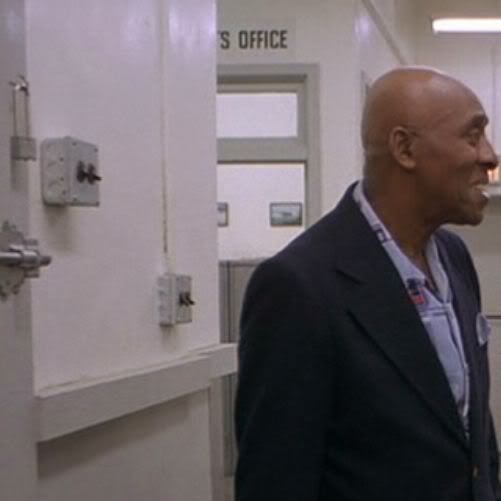
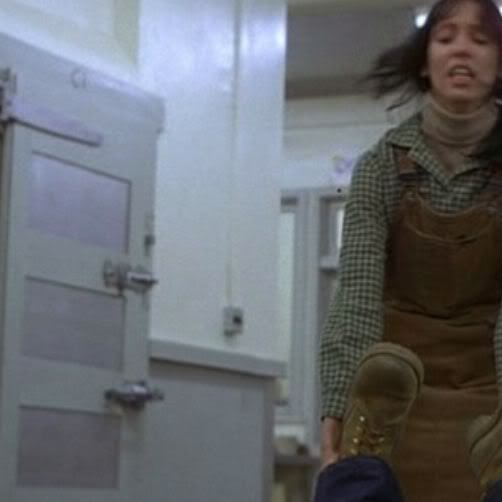
As the yellow ball is rolled toward Danny the carpet reverses between shots.


The artwork on the table behind Jack is gone.


The statue and sofa both disappear.

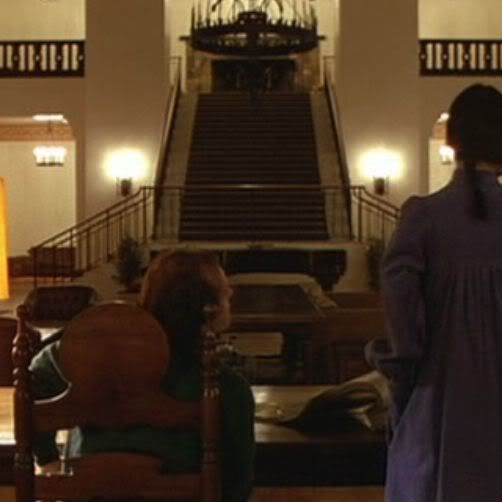
The scrapbook closes and the typewriter moves to the left without being touched by anyone.


The plants above their heads disappear as the movie progresses.


This light switch appears later in the movie.


The shower head disappears.


The mirror in the back disappears later in the movie.


The stand that the Gold Room Sign is on changes throughout the movie.


"Great party isn't it" as the artwork behind him disappears.
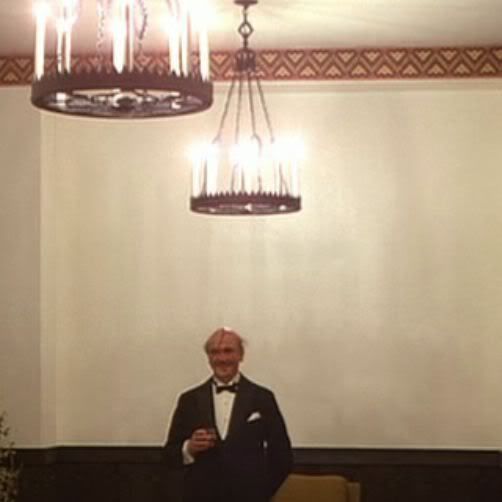

Plastic flowers appear on the table between shots.


The penholder disappears between shots.


Jack’s OJ gets lower and the milk disappears.


Watch as Dick Hallorann’s pile of change and red cap at the airport payphone move constantly without him touching them with either hand.


The Gold Room light switches disappear throughout the movie.


The cigarettes on the nightstand disappear between shots.
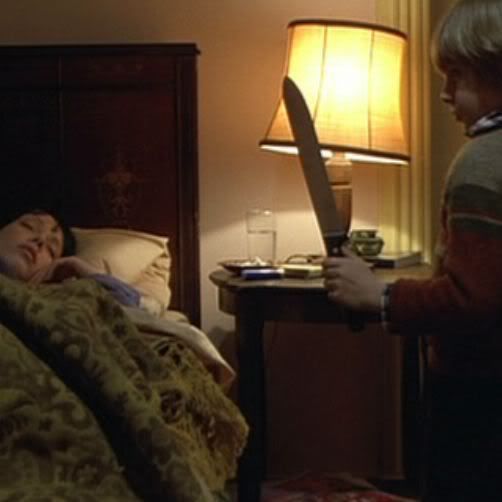

Jack swings so hard that the chairs on the right move forward about six inches between shots.




The fire extinguisher disappears.


The chair and table disappear between shots.


The spoon on the table in the back disappears as the scene progresses.


Everything on Wendy's dresser moves between shots without being touched.


Dick Hallorann's body moves even though he’s dead.


The chairs disappear throughout the scene.


A blue folder appears and the phone disappears between shots.


The box with the novel in it appears between shots.


The bearskin rug disappears.

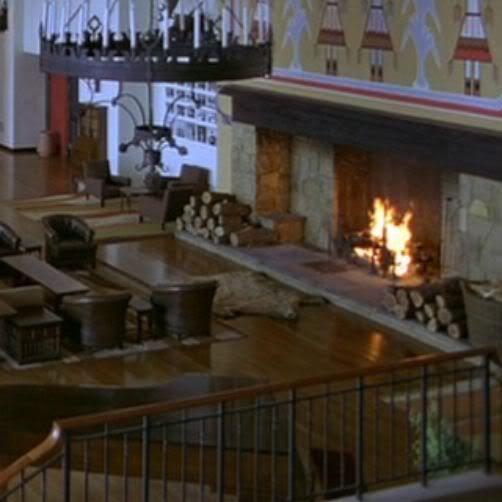


This mysterious clock moves away from the power line.


The light switch on the left disappears.


As the yellow ball is rolled toward Danny the carpet reverses between shots.


The artwork on the table behind Jack is gone.


The statue and sofa both disappear.


The scrapbook closes and the typewriter moves to the left without being touched by anyone.


The plants above their heads disappear as the movie progresses.


This light switch appears later in the movie.


The shower head disappears.


The mirror in the back disappears later in the movie.


The stand that the Gold Room Sign is on changes throughout the movie.


"Great party isn't it" as the artwork behind him disappears.


Plastic flowers appear on the table between shots.


The penholder disappears between shots.


Jack’s OJ gets lower and the milk disappears.


Watch as Dick Hallorann’s pile of change and red cap at the airport payphone move constantly without him touching them with either hand.


The Gold Room light switches disappear throughout the movie.


The cigarettes on the nightstand disappear between shots.


Jack swings so hard that the chairs on the right move forward about six inches between shots.


The page of The Hotel scrapbook changes between shots without being touched.


The fire extinguisher disappears.


The chair and table disappear between shots.


The spoon on the table in the back disappears as the scene progresses.


Everything on Wendy's dresser moves between shots without being touched.


Dick Hallorann's body moves even though he’s dead.


The chairs disappear throughout the scene.


A blue folder appears and the phone disappears between shots.


The box with the novel in it appears between shots.


The bearskin rug disappears.


Subscribe to:
Posts (Atom)